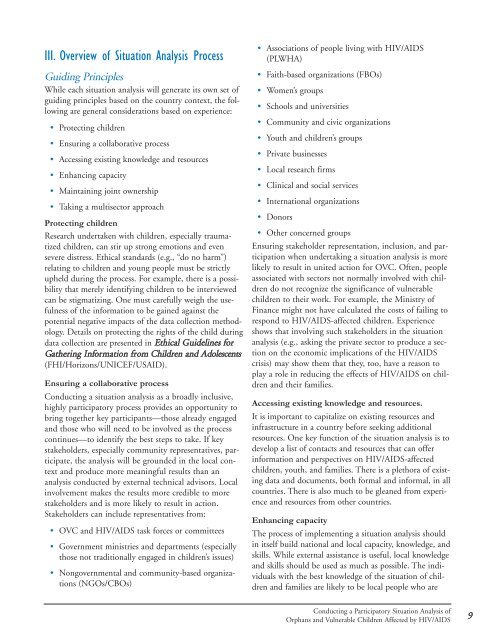Conducting a Participatory Situation Analysis of.pdf - Global HIV ...
Conducting a Participatory Situation Analysis of.pdf - Global HIV ...
Conducting a Participatory Situation Analysis of.pdf - Global HIV ...
Create successful ePaper yourself
Turn your PDF publications into a flip-book with our unique Google optimized e-Paper software.
III. Overview <strong>of</strong> <strong>Situation</strong> <strong>Analysis</strong> Process<br />
Guiding Principles<br />
While each situation analysis will generate its own set <strong>of</strong><br />
guiding principles based on the country context, the following<br />
are general considerations based on experience:<br />
• Protecting children<br />
• Ensuring a collaborative process<br />
• Accessing existing knowledge and resources<br />
• Enhancing capacity<br />
• Maintaining joint ownership<br />
• Taking a multisector approach<br />
Protecting children<br />
Research undertaken with children, especially traumatized<br />
children, can stir up strong emotions and even<br />
severe distress. Ethical standards (e.g., “do no harm”)<br />
relating to children and young people must be strictly<br />
upheld during the process. For example, there is a possibility<br />
that merely identifying children to be interviewed<br />
can be stigmatizing. One must carefully weigh the usefulness<br />
<strong>of</strong> the information to be gained against the<br />
potential negative impacts <strong>of</strong> the data collection methodology.<br />
Details on protecting the rights <strong>of</strong> the child during<br />
data collection are presented in Ethical Guidelines for<br />
Gathering Information from Children and Adolescents<br />
(FHI/Horizons/UNICEF/USAID).<br />
Ensuring a collaborative process<br />
<strong>Conducting</strong> a situation analysis as a broadly inclusive,<br />
highly participatory process provides an opportunity to<br />
bring together key participants—those already engaged<br />
and those who will need to be involved as the process<br />
continues—to identify the best steps to take. If key<br />
stakeholders, especially community representatives, participate,<br />
the analysis will be grounded in the local context<br />
and produce more meaningful results than an<br />
analysis conducted by external technical advisors. Local<br />
involvement makes the results more credible to more<br />
stakeholders and is more likely to result in action.<br />
Stakeholders can include representatives from:<br />
• OVC and <strong>HIV</strong>/AIDS task forces or committees<br />
• Government ministries and departments (especially<br />
those not traditionally engaged in children’s issues)<br />
• Nongovernmental and community-based organizations<br />
(NGOs/CBOs)<br />
• Associations <strong>of</strong> people living with <strong>HIV</strong>/AIDS<br />
(PLWHA)<br />
• Faith-based organizations (FBOs)<br />
• Women’s groups<br />
• Schools and universities<br />
• Community and civic organizations<br />
• Youth and children’s groups<br />
• Private businesses<br />
• Local research firms<br />
• Clinical and social services<br />
• International organizations<br />
• Donors<br />
• Other concerned groups<br />
Ensuring stakeholder representation, inclusion, and participation<br />
when undertaking a situation analysis is more<br />
likely to result in united action for OVC. Often, people<br />
associated with sectors not normally involved with children<br />
do not recognize the significance <strong>of</strong> vulnerable<br />
children to their work. For example, the Ministry <strong>of</strong><br />
Finance might not have calculated the costs <strong>of</strong> failing to<br />
respond to <strong>HIV</strong>/AIDS-affected children. Experience<br />
shows that involving such stakeholders in the situation<br />
analysis (e.g., asking the private sector to produce a section<br />
on the economic implications <strong>of</strong> the <strong>HIV</strong>/AIDS<br />
crisis) may show them that they, too, have a reason to<br />
play a role in reducing the effects <strong>of</strong> <strong>HIV</strong>/AIDS on children<br />
and their families.<br />
Accessing existing knowledge and resources.<br />
It is important to capitalize on existing resources and<br />
infrastructure in a country before seeking additional<br />
resources. One key function <strong>of</strong> the situation analysis is to<br />
develop a list <strong>of</strong> contacts and resources that can <strong>of</strong>fer<br />
information and perspectives on <strong>HIV</strong>/AIDS-affected<br />
children, youth, and families. There is a plethora <strong>of</strong> existing<br />
data and documents, both formal and informal, in all<br />
countries. There is also much to be gleaned from experience<br />
and resources from other countries.<br />
Enhancing capacity<br />
The process <strong>of</strong> implementing a situation analysis should<br />
in itself build national and local capacity, knowledge, and<br />
skills. While external assistance is useful, local knowledge<br />
and skills should be used as much as possible. The individuals<br />
with the best knowledge <strong>of</strong> the situation <strong>of</strong> children<br />
and families are likely to be local people who are<br />
<strong>Conducting</strong> a <strong>Participatory</strong> <strong>Situation</strong> <strong>Analysis</strong> <strong>of</strong><br />
Orphans and Vulnerable Children Affected by <strong>HIV</strong>/AIDS<br />
9















